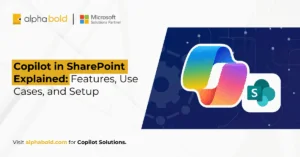Table of Contents
Introduction:
In this blog, we’ll explore key SharePoint governance strategies that can help your organization stay aligned with its business goals.
Are you struggling to manage your SharePoint environment effectively? Do you find it challenging to ensure consistent usage and content control across departments? You’re not alone. A recent AIIM survey shows that 40% of organizations don’t consider their SharePoint implementation successful. But with the right governance strategies and policies in place, SharePoint can become a true driver of productivity and collaboration.
SharePoint Governance Strategies and Policies
Governance refers to the policies, roles, responsibilities, and processes that guide collaboration between your organization’s business and IT teams. SharePoint governance strategies focus on managing platform usage, access permissions, and content workflows in a structured and scalable way.
Below are the most important aspects to consider when defining your SharePoint governance framework:
1. Governance Objectives:
- Establish Goals and Objectives: Clearly articulate the aims of SharePoint governance, including ensuring data security, enhancing collaboration, and adhering to organizational policies and regulations.
- Harmonize with Business Goals: Ensure that the governance is in sync with overarching business objectives and contributes to organizational priorities.
2. Roles and Responsibilities:
Delegate Governance Roles: Specify roles that oversee governance, including administrators, site owners, and content managers.
Define Responsibilities: Clearly delineate each role’s duties regarding permissions management, content lifecycle, and adherence to governance policies.
3. Permissions Management:
Permissions Framework: Set up a hierarchical permission structure that addresses the principle of least privilege, managing access to SharePoint sites, libraries, and content.
Ongoing Evaluation: Perform regular assessments of permissions to ensure they meet current business requirements and organizational adjustments.
4. Content Management:
Content Lifecycle: Define policies and procedures for content creation, storage, sharing, and archival. Have a content governance framework in place to determine till when the content is valid and when it should be deleted or archived.
Metadata and Tagging: Implement Metadata and tagging strategies to improve content discoverability and organization.
Version Control: Enforce version control to track document changes and ensure users access the latest versions.
5. Compliance and Security:
Data Governance: Implement policies to ensure data integrity, confidentiality, and compliance with regulatory requirements (e.g., GDPR, HIPAA).
Security Measures: Configure security settings such as encryption, access controls, and multi-factor authentication to protect data from unauthorized access and cyber threats.
You may also like: Why Professional SharePoint Migration Services Are Worth the Investment
6. Monitoring and Auditing:
Monitor Usage: Track usage patterns, site activity, and storage utilization to identify potential issues or areas for improvement.
Regular Audits: Conduct regular audits to assess compliance with governance policies, identify security vulnerabilities, and ensure adherence to established procedures.
Schedule a SharePoint Consultation Today
Are you struggling with SharePoint management? Consult AlphaBOLD's experts to discover how tailored governance solutions can benefit your organization.
Request a Consultation7. Training and Awareness:
User Training: Provide training programs and resources to educate users about features, governance policies, and best practices for content management.
Promote Awareness: Regular communication is essential to reinforce SharePoint governance strategies, keeping users informed about policy updates, platform expectations, and secure usage practices.
8. Continuous Improvement:
Feedback Mechanism: Establish a feedback mechanism to gather input from users and stakeholders regarding governance effectiveness and areas needing improvement.
Review and Adapt: Regularly review governance policies and strategies to adapt to evolving business needs, technological advancements, and changes in regulatory requirements.
How AlphaBOLD’s SharePoint Governance Strategies Have Benefited Businesses
By employing advanced security protocols and success-proven data management practices, AlphaBOLD has helped multiple SMBs protect sensitive information, reduce the risk of data breaches, and ensure compliance with industry regulations. This has not only improved data accessibility and organization but also streamlined workflows, leading to increased productivity and cost savings.
While working with AlphaBOLD, a leading genomic healthcare company, leveraged Microsoft SharePoint to overcome its internal challenges with a modern intranet solution. Read the full story here: Intranet Modernization for Genomic Healthcare Company with SharePoint.
Our success with SharePoint shows how we can tailor the solution to your needs while ensuring impenetrable security and governance.
Conclusion
Implementing effective SharePoint governance strategies is key to unlocking the platform’s potential. Organizations can build a structured environment supporting compliance and collaboration by clearly defining roles and responsibilities, enforcing robust policies, and securing access.
Regular monitoring, auditing, and user training ensure continued alignment with evolving needs. For IT and business leaders alike, a well-governed SharePoint environment enables better productivity, data protection, and cross-team efficiency.
Expereince Sucess with SharePoint
Ready to transform your SharePoint environment into a powerful tool for collaboration and productivity? Partner with AlphaBOLD to implement effective governance strategies.
Request a ConsultationExplore Recent Blog Posts








